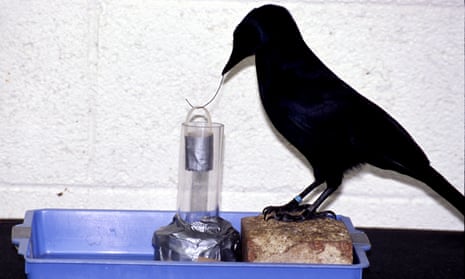A crow that astonished the world by bending a straight piece of wire was simply acting out behaviour in her species’ natural repertoire, a study has found.
Betty bent a straight piece of garden wire into a neat hook to lift a food-baited bucket from a vertical tube in a laboratory at the University of Oxford in 2002.
At the time it was known that New Caledonian crows manufactured tools from twigs in the wild, but it seemed highly unlikely that this involved bending.
The resulting paper from the experiment suggested that Betty had spontaneously come up with a clever solution after understanding the experimental task.
This shook the field of comparative cognition and was regarded as one of the most compelling demonstrations of intelligence in a non-human animal.
But recent field experiments by biologists at the University of St Andrews have found that tool bending is part of New Caledonian crows’ natural behaviour.
Dr Christian Rutz was leader of the project, the findings of which are published in Royal Society Open Science.
“We couldn’t believe our eyes,” Dr Rutz said.
“Most birds trapped sticks underfoot before bending the tool shaft by bill, but one also pushed tools against the logs to flex them, and another wedged them upright into holes before pulling the shaft sideways, just as Betty had done.
“It turns out the twigs that wild crows select for making their tools are pliable.
“Our study is a powerful reminder of the importance of basic natural history research.
“When my Oxford colleagues studied Betty’s cognitive abilities almost 15 years ago, very little was known about how these birds make and use tools in their natural tropical habitat.
“Our discovery of tool bending in wild New Caledonian crows has come as a complete surprise, and was the result of patient field research.”
The researchers provided the wild-caught crows with juicy treats hidden in wooden logs, as well as their preferred plant material to manufacture tools.
New Caledonian crows live in the remove tropical archipelago of New Caledonia, South Pacific, where the research for the study took place.
Birds were briefly kept in field aviaries before being released back into the wild.
Dr Rutz said the researchers were “absolutely over the moon” when the birds began making and using tools in their field aviaries.
Some of the crows vigorously bent their twig tools during processing in the same manner as Betty had bent wire in the Oxford experiment.
This time, however, bent tools were not required to solve the task.
James St Clair, report co-author, said: “Our observations raise the question of why wild crows would bend their stick tools as a matter of course.
“We believe a curved tool is advantageous, because the bird can position it in its bill so that the tool-tip is bang in the middle of the field of binocular vision.
“This should improve tool control during foraging.”
The observations suggest Betty may have followed familiar tool-processing routines, rather than inventing a clever solution to a novel problem.
However the researchers say they do not necessarily rule out the possibility that she understood the task and expressed innovative behaviour.
“New Caledonian crows are gifted tool users,” Dr St Clair added.
“The highly dexterous behaviour we observe in adult birds is the outcome of complex interactions between genetic predispositions and lifelong individual and social learning - a process that we don’t yet fully understand.
“In light of our new results, more experiments are needed to figure out what exactly these birds are capable of.”
Betty was one of two New Caledonian crows kept at the University of Oxford at the time the wire-bending experiment was conducted. She died in 2005.
In 2009, a team led by Nathan Emery recreated the Betty experiment using rooks, a species not known to use foraging tools in the wild.
The birds were also capable of bending wire into hooks to lift a baited bucket from apparatus.
Tool bending in New Caledonian crows is published in Royal Society Open Science.

Comments (…)
Sign in or create your Guardian account to join the discussion